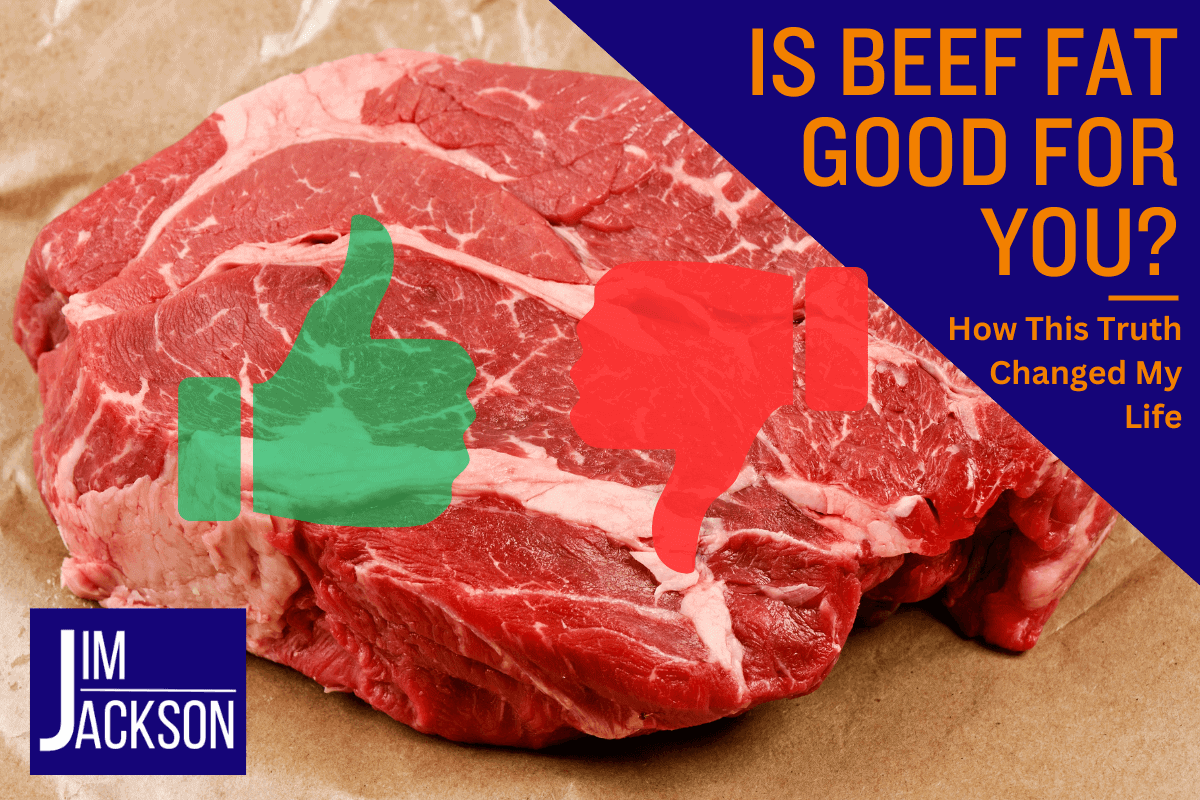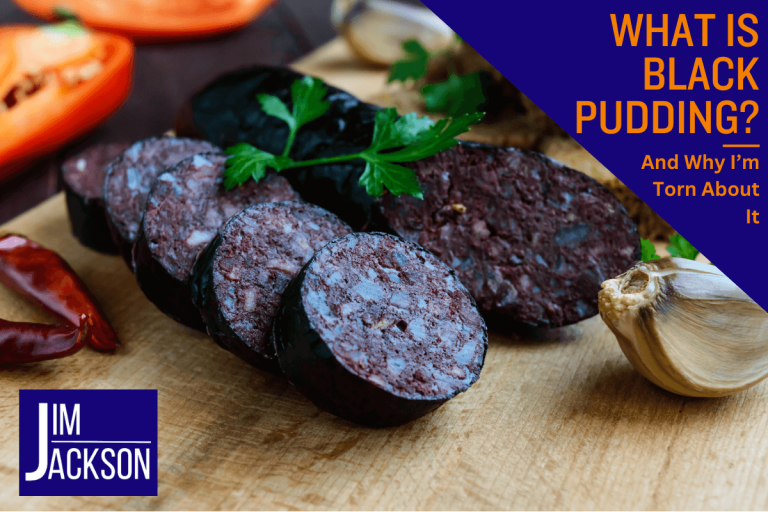Is Beef Fat Good for You? How This Truth Changed My Life
If I had been asked the question, “Is beef fat good for you?” 10 years ago, I would have said, “D’ah, of course it isn’t; everyone knows that.”
At that time, I was struggling with chronic fatigue syndrome. Constantly tired, depressed, anxious, and living one day to the next.
In 2016, I discovered low-carb/keto diets, which advocated cutting fake food and eating lots of animal fats. So, seed oils were out, and animal fats, including beef fat, were in.
That’s when my life changed, and I went from barely surviving to thriving and enjoying my life again. But I was left confused. How could this be when I’m now eating fats that are supposed to be so bad for me?
The more I thought about it, the more I realized that mainstream advice made no sense. Seed oils and other human-made fats have only been around for a few years, but we’ve been eating animal fat for millennia.
We don’t need to be a nutritionist, doctor, or scientist to figure this out. A little of the common sense we’ve all been blessed with tells us all we need to know.
So, what is beef fat, really? If it is good for us after all, what health benefits does it offer?
And how the bloody hell did we end up so far off track regarding beef fat?
TL;DR
- Beef fat (including suet and tallow) is a rich source of fatty acids, fat-soluble vitamins, and essential nutrients, making it a valuable part of a healthy diet.
- Modern fears about saturated fat and heart disease are based on outdated science. Natural fats, like stearic acid, found in beef meat, have shown neutral or even beneficial effects on LDL cholesterol.
- Grass-fed beef fat offers a better fatty acid composition than grain-fed beef. It contains more omega-3s, CLA, and antioxidants, which support heart health and reduce inflammation.
- Seed oils are highly processed and inflammatory and contribute to chronic illness—unlike beef fat, which humans have safely eaten for millennia. Common sense says to stick with real food.
The Different Types of Beef Fat (and Why They Matter)

Not all beef fat is the same, and understanding the differences can help you appreciate why it’s a health powerhouse rather than something to fear.
Intramuscular Fat (a.k.a. Marbling) – The Flavor King
This is the fat you see running through a juicy steak. More marbling generally means more flavor, tenderness, and a richer mouthfeel. But it’s not just about taste—this type of fat contains high amounts of oleic acid, the same heart-friendly fat found in olive oil.
Subcutaneous Fat – The Forgotten Superfood
The thick layer of fat found under an animal’s skin is called a fatty layer. Modern diets often trim this layer off, but our ancestors didn’t make that mistake.
This fat is used to make beef tallow, an incredible cooking fat. It is stable at high heat and packed with nutrients. Unlike vegetable oils, it doesn’t oxidize or turn rancid when heated.
Suet – The Hidden Gem of Animal Fats
A lesser-known but equally valuable fat is suet, the dense, nutrient-rich fat surrounding an animal’s kidneys and loins. It has a higher melting point than regular subcutaneous fat, making it perfect for rendering into tallow, baking, or even traditional high-energy foods like pemmican.
Suet is one of the most concentrated sources of essential fatty acids and fat-soluble vitamins, making it a powerful ancestral superfood that has been unjustly forgotten in modern diets.
So, if you’ve been told to avoid fat, the real question is: Why? Is it because of solid science or just outdated advice that doesn’t hold up to scrutiny? Let’s break it down further.
Beef Fat: A Nutritional Powerhouse

Now that we’ve established that beef fat isn’t just flavor-packed but also an essential part of an ancestral diet, let’s talk about what’s inside. Because, contrary to what you’ve been told, it’s not just “empty calories” or something to be scraped off your plate.
Packed With Essential Nutrients
Beef fat isn’t just fuel—it’s loaded with fat-soluble vitamins like vitamins D and E, crucial for immune function, bone strength, and skin health. Unlike plant-based sources, these nutrients are in their most bioavailable form, meaning your body absorbs and uses them efficiently.
It’s also a source of trace minerals like iron and zinc, which are essential for energy production, brain function, and overall well-being. If you’ve been struggling with fatigue or brain fog, your body might not need another kale smoothie—it might just need more nutrient-dense fat.
Fatty Acids: The Building Blocks of Health
The type of fat you eat matters. Beef fat is naturally balanced with a mix of saturated and unsaturated fats, giving your body exactly what it needs for sustained energy and cell function.
- Stearic acid, a type of saturated fat found in beef, has been shown to have neutral or even beneficial effects on cholesterol levels despite the outdated claims that saturated fat is harmful.
- Conjugated linoleic acid (CLA), another fatty acid in beef, has been linked to better metabolism, reduced inflammation, and even potential cancer-fighting properties.
- Omega-3s vs. Omega-6s – Beef from grass-fed cattle contains a healthier ratio of omega-3 to omega-6 fatty acids, reducing inflammation and supporting heart function. Grain-fed beef, on the other hand, has a higher omega-6 content, which can contribute to chronic inflammation when consumed excessively.
So, if beef fat is this nutrient-packed, why has it been demonized for so long? Let’s tackle the elephant in the room—saturated fat and heart disease.
The Truth About Saturated Fat and Heart Health

For decades, we were told that eating saturated fat clogs arteries and leads to heart disease. But modern research has punched holes in this theory, revealing that saturated fat isn’t the villain it was made out to be.
Does Saturated Fat Really Cause Heart Disease?
The idea that saturated fat is a direct cause of heart disease came from outdated studies and weak correlations—not solid science. In fact, multiple large-scale reviews have found no consistent link between saturated fat intake and an increased risk of heart disease.
Here’s what we do know:
- Stearic acid, one of the main saturated fats in beef, does not raise LDL cholesterol the same way processed fats do.
- Countries that consume higher amounts of natural animal fats, like France (hello, butter, and steak lovers), have lower heart disease rates than those that rely on processed vegetable oils.
- Refined sugars, processed carbohydrates (junk food), and industrial seed oils are the real culprits. These foods promote inflammation and contribute to arterial damage.
So, if you’re worried about heart health, swapping natural animal fat for seed oils isn’t the solution—it’s part of the problem.
Grass-Fed vs. Grain-Fed Beef Fat: Which is Better?
Not all beef fat is created equal. How cattle are raised and fed directly impacts the quality of their fat—and, by extension, its effects on your health.
Grass-Fed Beef Fat: A Nutrient Powerhouse

Cattle that roam freely and eat natural forage (grass, leaves, and shrubs) produce beef fat with a superior fatty acid composition. Compared to grain-fed beef, grass-fed beef contains:
- More Omega-3s – Essential for brain function, reducing inflammation, and supporting heart health.
- Higher CLA (Conjugated Linoleic Acid) – A fatty acid linked to better metabolism, immune function, and even cancer-fighting properties.
- More Vitamins and Antioxidants – Including higher levels of vitamin E that helps protect cells from damage.
Grain-Fed Beef Fat: The Inflammatory Downside
Grain-fed cattle are typically raised on corn, soy, and other feedlot grains to fatten them up quickly. This alters the fat composition in a few key ways:
- Higher Omega-6 to Omega-3 Ratio—Too much omega-6 (common in processed foods) promotes chronic inflammation linked to heart disease and other metabolic disorders.
- Less CLA and Antioxidants—Grain-fed beef has lower levels of beneficial fatty acids and nutrients that fight inflammation.
- Can Contain Residual Toxins—Grain-fed cattle are often given antibiotics and hormones to promote growth, which can accumulate in their fat.
Which One Should You Choose?
If your goal is optimal health, the answer is clear—grass-fed beef fat is the better choice. It contains a healthier balance of fatty acids, essential nutrients, and anti-inflammatory compounds.
That said, grain-fed beef is still far better than ultra-processed foods and seed oils. If grass-fed isn’t an option, choosing high-quality fatty cuts of red meat from grain-fed sources is still a much better alternative to modern, industrialized food products.
Cooking with Beef Fat: Why It’s Superior to Vegetable Oils
For thousands of years, humans cooked with animal fat—whether it was beef tallow, lard, or duck fat. Then, somewhere along the line, we were told that these natural, nutrient-dense fats were bad for us.
And what replaced them? Highly processed seed oils—one of the most insidious dietary poisons of the modern world.
Beef Tallow: The Gold Standard of Cooking Fats

Beef tallow is rich in beneficial fatty acids, heat-stable, and packed with essential nutrients. It has been a trusted cooking fat for centuries because:
- Its high smoke point makes it ideal for frying and roasting without causing it to break down into harmful compounds.
- Unlike coconut oil or olive oil, it remains stable at high heat, preserving its nutritional integrity.
- Properly stored, beef tallow can last up to a year, making it an incredibly practical and shelf-stable fat source.
It’s a natural, time-tested fat that fueled generations of strong, healthy people. But instead of sticking with what worked, we were told to switch to something better—industrial seed oils.
Seed Oils: The Slow, Silent Poison

Seed oils (canola, soybean, corn, sunflower, etc.) are modern inventions engineered through high-heat chemical processing.
They require deodorizers to mask the rancid smell and stabilizers to prevent them from going bad too quickly. Yet, they’re sold as “heart-healthy” alternatives.
But here’s the reality: Seed oils are toxic. Not in a way that kills you immediately, but in a way that slowly, methodically damages your health over time—so gradually that most people never notice until it’s too late.
Here’s why:
- High in Omega-6 Fatty Acids – Unlike grass-fed beef fat, which has a healthy balance of omega-3s and omega-6s, seed oils are loaded with inflammatory omega-6s. Chronic inflammation is a key driver of obesity, metabolic disorders, and heart disease.
- Easily Oxidized – When exposed to heat, these oils break down into harmful compounds, releasing toxic aldehydes that damage cells, contribute to cancer, and accelerate aging.
- Linked to Metabolic Disease – Seed oils disrupt insulin sensitivity, promote fat storage, and contribute to obesity, diabetes, and heart disease.
If seed oils are so dangerous, why are they still everywhere?
Because they’re cheap to produce and highly profitable. It’s easier (and far more lucrative) to convince people that natural animal fats are bad while pushing an industrial product designed in a lab.
One of my heroes, Paul Saladino, explains it so well in this video…
Use Common Sense: Which Fat Would You Trust?
If you had to choose between:
🍖 A fat that humans have been eating for millennia as hunter-gatherers and cavemen—one that’s naturally occurring, nutrient-dense, and stable at high heat.
🔬 A fat that requires industrial processing, chemical solvents, and deodorization before it’s even edible.
Which would you pick?
The answer is obvious. Beef fat is not the enemy—seed oils are. They are one of the greatest dietary scams in history, and their slow, insidious damage to human health is only now being fully understood.
Want better health? Ditch the seed oils, cook with beef tallow, and stop fearing the foods that have sustained humans for thousands of years.
Why You Should Be Eating More Beef Fat (Not Less)

If we stop fearing fat and start thinking logically, it becomes obvious: Humans have been eating fatty meat for thousands of years without the chronic diseases we see today.
It was only when we started substituting beef tallow for processed oils and red meat for ultra-processed foods that things went downhill.
Here’s why adding beef fat to your diet makes sense:
- Satisfying and Keeps You Full: Unlike refined carbs that leave you hungry an hour later, beef fat provides long-lasting energy.
- Perfect for a Keto or Carnivore Diet: Zero carbs, highly digestible, and packed with nutrients.
- Supports a Healthy Metabolism: Contains essential fatty acids and fat-soluble vitamins crucial for optimal body function.
- Great for Cooking: Beef tallow is stable at high heat, unlike vegetable oils, which oxidize and become toxic when heated.
So, the next time someone tells you to trim the fat off your steak, consider asking why.
Conclusion: Is Beef Fat Good for You?
Nutrition science can feel like a never-ending argument. One day, eggs are bad, the next, they’re a superfood. Fat was demonized for decades, and now even mainstream health circles are starting to admit they got it wrong.
Instead of getting caught up in the back-and-forth, use common sense. If a food has sustained humans for thousands of years, it’s probably good for you. If it’s only been around for a few decades and requires heavy processing to exist (hello, margarine and seed oils), it’s probably not.
Beef fat isn’t just good for you—it’s one of the most nutrient-dense, bioavailable sources of energy available. The real problem? We’ve been told to fear the very foods that kept our ancestors strong and healthy.
Beef fat is part of what I call the ultimate human diet or what is sometimes called the animal-based diet. These prioritize animal foods as the main source of nutrients, with other real food, such as fruit and veggies, as complementary and ideally seasonal.
Eating this way has helped me regain my health and start enjoying life again after years of chronic fatigue misery.
And that’s it… have a nutritious day!
FAQs
Is beef fat bad for your heart?
No. The fear of beef fat comes from outdated studies. In reality, beef’s stearic acid and other natural saturated fats do not increase heart disease risk. Inflammation from processed foods and seed oils is a bigger concern.
What’s the difference between grass-fed and grain-fed beef fat?
Grass-fed beef is superior because it contains a better omega-3 to omega-6 fatty acids balance. Grain-fed beef has more omega-6, which can contribute to inflammation if consumed excessively.
Is beef fat better than vegetable oil for cooking?
Yes. Beef tallow is more heat-stable and doesn’t break down into harmful compounds like vegetable oils do. It’s also packed with beneficial nutrients.
Can beef fat help with weight loss?
Yes. Beef fat is highly satiating, meaning it keeps you full for longer and helps regulate appetite. It also supports healthy metabolism and hormone function.
Does beef fat have any essential nutrients?
Absolutely! It contains fat-soluble vitamins like vitamins D and E, stearic acid, conjugated linoleic acid (CLA), and essential fatty acids crucial for overall health.







